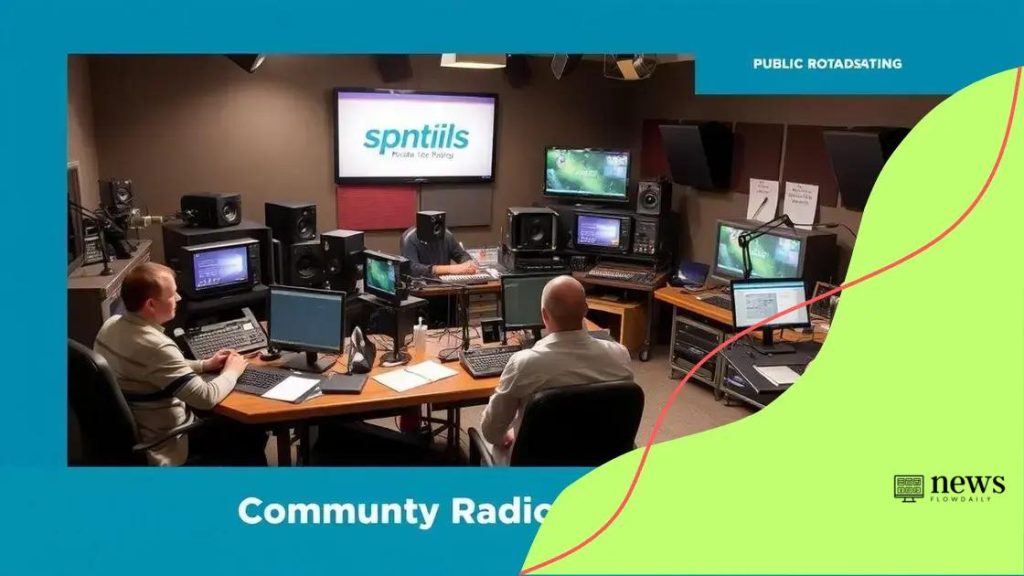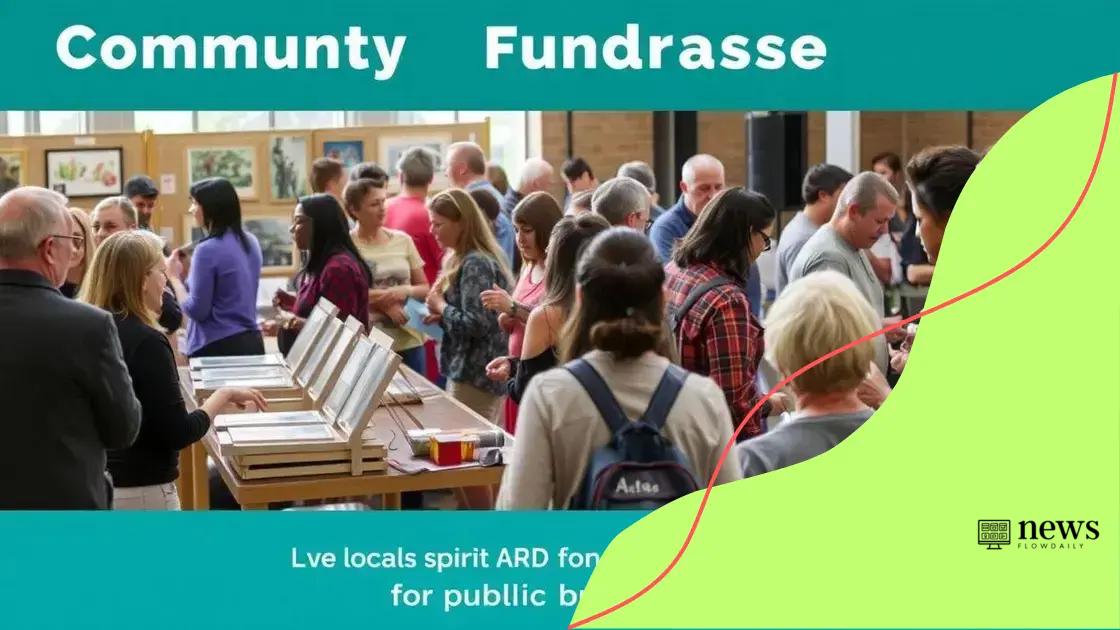Public broadcasting funding cuts: what they mean for you

Public broadcasting funding cuts significantly reduce the variety and quality of programming, leading communities to advocate for increased support and explore new funding sources to sustain essential media services.
Public broadcasting funding cuts have sparked significant discussions about their effects on our communities. Have you noticed changes in your favorite shows or local news? Let’s dive into what these cuts really mean for you.
Understanding the impact of funding cuts
Understanding the impact of funding cuts in public broadcasting is essential for everyone who consumes media. These cuts can lead to noticeable changes in the quality and quantity of programming available to the public. How does this affect you and your community?
Immediate Effects on Programming
One of the first areas impacted by funding cuts is programming diversity. A reduction in funds often means that public broadcasters have to scale back on the variety of shows they provide. This can lead to:
- Fewer local news segments
- Reduced availability of educational programming
- Limited access to culturally significant content
As funding decreases, stations may prioritize popular shows over less mainstream programming. This shift means that audiences might miss out on unique perspectives and important topics that deserve attention.
Community Responses and Adaptations
Communities often come together when faced with funding challenges. Many local organizations and advocacy groups begin campaigns to support their public broadcasters. These efforts can include:
- Fundraising events
- Public awareness campaigns
- Advocacy for reinstating funds
People realize that public broadcasting is vital for maintaining informed citizens and community engagement. As citizens advocate for their stations, they often find new ways to support them, including volunteering and contributing financially.
Moreover, when faced with cuts, some public broadcasters turn to alternative funding sources, which may come with their own set of challenges. For instance, relying more on sponsorship can influence program content, shifting the focus to what sponsors deem attractive.
Long-term Effects and Trends
The long-term effects of funding cuts can be dire if trends continue unchecked. Research indicates that consistent cuts can lead to:
- A decline in overall audience trust
- Increased difficulty in attracting quality talent
- Challenges in upholding journalistic standards
As audiences notice gaps in programming, trust in public broadcasting may wane, leading to a vicious cycle of declining viewership and even more budget cuts. It’s crucial for communities to understand the risks and take action.
Ultimately, the health of public broadcasting is at stake. Keeping a pulse on funding changes and their ripple effects helps communities advocate effectively for sustainable media resources.
How funding changes affect programming
Funding changes can significantly impact the programming that public broadcasters provide. When budgets shrink, stations face tough choices that affect what viewers are able to watch. It’s important to understand these effects and how they ripple through our access to information.
Reduction in Program Variety
A primary consequence of funding cuts is a noticeable decline in the variety of programs. Public broadcasters might reduce niche or local shows to focus on those that attract higher viewership. This leads to:
- Fewer educational programs that inspire learning.
- Less representation of diverse communities and stories.
- Limited cultural programming that connects people to their heritage.
As a result, audiences may find fewer options that reflect their interests and backgrounds.
Changes in Quality of Content
Not only does funding influence program variety, but it also affects the quality of the content produced. A decrease in financial resources can lead to:
- Lower production values.
- Fewer opportunities for investigative journalism.
- Less time for thorough research and fact-checking.
With fewer funds, stations often must prioritize quantity over quality, which can diminish the overall viewer experience. Important stories might not receive the depth and attention they deserve because of a lack of resources.
Moreover, some public broadcasters might rely on sponsored content to fill gaps. While this can provide necessary funding, it raises concerns about the potential influence of advertisers on programming decisions.
Viewer Engagement and Feedback
As public broadcasting channels change their programming in response to funding adjustments, viewer engagement becomes even more critical. Feedback from audiences can be a valuable tool for broadcasters. When they hear directly from viewers about what types of content they value, stations may be more inclined to adjust their offerings.
Engagement can also manifest through social media platforms, where audiences can express their preferences and concerns. This connection helps maintain a dialogue about what communities truly need from their public broadcasters as funding continues to fluctuate.
Community responses to public funding cuts

Community responses to public funding cuts often play a crucial role in shaping the future of local media. When funding decreases, people realize how essential public broadcasting is to their lives. This awareness leads to varied and creative responses from the community.
Grassroots Movements
A common response to funding cuts is the emergence of grassroots movements. These initiatives bring together individuals who value their public broadcasters. Examples of community actions include:
- Organizing local fundraising events
- Creating petitions to restore funding
- Advocating for increased support from local government
Such actions show the strength of community support for public media. They highlight the voices of citizens who believe in the value of local news and educational programming.
Collaboration with Local Organizations
Communities often collaborate with local organizations to amplify their efforts. By working together, they can reach more people and generate more impact. Collaborations can take many forms, such as:
- Partnerships with schools to raise awareness
- Engaging local businesses as sponsors or donors
- Hosting community forums to discuss broadcasting needs
Through these partnerships, communities can not only raise funds but also foster a deeper appreciation for the role of public broadcasting.
As community members share their stories and needs, public broadcasters often listen. This feedback can lead to new programming that better reflects the interests and values of the community.
Cultural Events and Initiatives
Cultural events also serve as an effective way to rally support. Festivals, concerts, and exhibitions can bring people together to celebrate local talent while raising funds. These events can showcase:
- Local artists contributing their works
- Musicians performing to gather donations
- Workshops teaching valuable skills related to media production
These initiatives not only provide financial support but also strengthen community ties. They remind everyone of the importance of public broadcasting in their daily lives.
By highlighting local stories and engaging citizens, communities can effectively advocate for the continued existence and growth of their beloved public broadcasting services.
The role of advocacy in public broadcasting
Advocacy plays a vital role in shaping the future of public broadcasting. As funding for public media continues to face challenges, advocates work tirelessly to ensure these vital services remain strong and accessible to everyone. Understanding the importance of advocacy helps to appreciate how it influences the media landscape.
The Power of Public Engagement
Public advocates often mobilize communities to support their local broadcasters. This grassroots engagement is crucial in raising awareness about the significance of public media. Some ways that public engagement manifests include:
- Organizing letter-writing campaigns to lawmakers.
- Creating social media movements to share personal stories about the impact of public broadcasting.
- Hosting community meetings to educate citizens on funding issues.
By fostering dialogue within the community, advocates can ensure that the voices of the public are heard and considered in funding decisions.
Building Relationships with Policymakers
Effective advocacy often requires building strong relationships with policymakers. Advocates work to create connections that facilitate discussions about the needs and importance of public broadcasting. These relationships can lead to:
- Increased awareness of the value of funding public media.
- Better opportunities for public broadcasters to present their case.
- More informed decisions that take community needs into account.
When policymakers understand the impact of public broadcasting on their constituents, they are more likely to support funding initiatives.
Additionally, advocates often collaborate with organizations that specialize in media policy. These collaborations can amplify efforts to secure funding and ensure the sustainability of public broadcasting.
Utilizing Data and Research
Another important aspect of advocacy in public broadcasting is utilizing data and research to support claims. Advocates often gather statistics and testimonials that show how public media benefits communities. This evidence can bolster arguments by demonstrating:
- High audience engagement levels.
- Positive social impacts, such as improved education and community cohesion.
- Local content that reflects diverse cultures and perspectives.
With compelling data, advocates can persuade lawmakers and the public about the undeniable value of investing in public broadcasting.
Through dedicated efforts and informed strategies, advocacy can pave the way for stronger public broadcasting, ensuring that these essential services continue to thrive and serve communities effectively.
Future trends in public broadcasting funding
Understanding the future trends in public broadcasting funding is essential for grasping how media will evolve. As technology and society change, so do the ways public broadcasters seek and secure funding.
Increased Digital Engagement
With more people consuming media online, public broadcasters are adapting to this shift. Digital platforms allow them to reach wider audiences and explore new revenue streams. This includes:
- Developing mobile apps for easy access to content.
- Utilizing social media for audience engagement and fundraising.
- Creating on-demand content to attract younger audiences.
As they embrace digital strategies, public broadcasters can diversify their funding sources beyond traditional methods.
Public-Private Partnerships
Another growing trend is the formation of public-private partnerships. Collaborations with private organizations can provide essential funding and resources. These partnerships may lead to:
- Co-produced content that combines public and commercial interests.
- Shared resources for events and community outreach.
- Increased financial support for specialized programming.
While these collaborations offer new opportunities, they also raise questions about the independence of public broadcasting and the potential influence of sponsors.
Advocacy and Community Support
As funding challenges persist, advocacy remains vital. Communities are increasingly recognizing the importance of supporting their local broadcasters. Efforts might include:
- Grassroots campaigns to advocate for funding.
- Increased volunteer engagement to reduce operational costs.
- Creating awareness around the value of public broadcasting in a democracy.
By banding together, communities can amplify their voices and help secure funding for public broadcasters in the future.
As funding models evolve, the emphasis on transparency and accountability will likely grow. Audiences are demanding to know how their support is being used and the benefits they receive in return.
In conclusion, the future of public broadcasting depends on how communities adapt to funding challenges. More digital engagement and advocacy are essential to keep these services alive. Collaborating with private partners can also help secure necessary resources. The commitment of community members is key to ensuring that public broadcasting continues to provide valuable content. By working together, we can help preserve the diverse voices that enrich our society.
FAQ – Frequently Asked Questions about Public Broadcasting Funding
What are public broadcasting funding cuts?
Public broadcasting funding cuts refer to reductions in financial support from government sources or other funding agencies, impacting the availability of media services.
How do funding cuts affect programming?
Funding cuts can lead to a decrease in the variety and quality of programming, resulting in fewer local shows and educational content.
What role does advocacy play in public broadcasting?
Advocacy helps raise awareness and mobilize community support for public broadcasting, ensuring that funding and resources are available to maintain services.
What trends are shaping the future of public broadcasting funding?
Key trends include increased digital engagement, public-private partnerships, and a greater emphasis on community involvement and advocacy.





